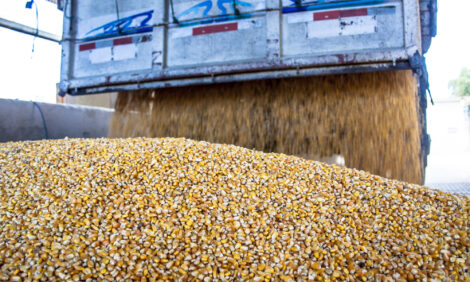



March Pig Crop Down 3 Percent - UPDATED
US - April 2003 Hogs and Pigs report from the USDA National Agricultural Statistics Service, updated with Ron Plain's commentary.USDA April Hogs and Pigs Report
The March 2003 U.S. pig crop at 8.32 million head, was 3 percent below the previous year. Sows
farrowing during this period totaled 940 thousand head, 4 percent below last year. The average pigs per
litter for March increased to 8.85, compared to 8.80 last year.
The U.S. inventory of sows and gilts on April 1, 2003, was 5.80 million head, down 3 percent from
April 1, 2002.
U.S. sows and gilts bred during March totaled 1.15 million head, down 3 percent from the previous
year.

Report Tables


Special Note
Monthly farrowing and pig crop estimates are preliminary and may be revised in the Quarterly Hogs and Pigs Reports. Various factors can require revisions, such as sample variability, difference in reporting time-frame (monthly vs. quarterly), and pre-weaning and post-weaning death loss. Please refer to the Revision Policy on Page 3 of this report for more information.
Reliability of April 2003 Hogs and Pigs Estimates
Survey Procedures: A random sample of 2,800 U.S. producers from contractors to independent producers were used to provide data for these estimates. Survey procedures ensured that all breeding and farrowing operations, regardless of size, had a chance to be included in the survey. Large producers were sampled more heavily than small operations. Data were collected during the first-half of the month by mail, telephone, and face-to-face personal interviews. Operations were asked to provide information on sow and gilt inventories as of the first of the month, sows and gilts bred during the previous month, sows and gilts farrowed during the previous month, and the pig crop from these litters.Revision Policy: Revisions to previous monthly estimates are made during the quarterly report. These revisions are to improve month to month, and quarter to quarter relationships. In December, estimates for all months and quarters of the current and previous year are reviewed. The reviews are primarily based on hog check-off receipts and slaughter. Estimates will also be reviewed after data from the Department of Agriculture five-year Census of Agriculture are available. No revisions will be made after that date.
Reliability: Since all operations with sow and gilt inventory are not included in the sample, survey estimates are subject to sampling variability. Survey results are also subject to non-sampling errors such as omissions, duplication, and mistakes in reporting, recording, and processing the data. The affects of these errors cannot be measured directly. They are minimized through rigid quality controls in the data collection process and through a careful review of all reported data for consistency and reasonableness.
Commentary on the report - Ron Plain
 Ron Plain |
USDA's April Hogs & Pigs report showed the number of pigs farrowed was down 3.4% from a year earlier. The inventory of sows and gilts held for breeding on April 1 was down 3.1%. This is a bit of a reversal because the breeding herd on March 1 was 4% below a year earlier. The good news is that the inventory of sows and gilts on April 1 was still 0.6% below March 1.
According to USDA, the inventory of sows and gilts on April 1, 2002, was down 1.6% from March 1, 2002. Based on the monthly data, in 2002 the breeding herd of sows and gilts held basically steady on May 1 with April 1 then grew a little on June 1 from May 1. The monthly data for 2003 also shows a slow decline each month until March 1, which was up slightly from February. The small increases in the breeding herd on June 1, 2002, and March 1, 2003, from a year earlier may be associated with the more accurate data of the quarterly report.
Producers bred 3% fewer sows during March than a year earlier. This was the tenth consecutive month with fewer sows and gilts bred than a year earlier.
Litters farrowed during March were down 3.4%. This is very consistent with second quarter farrowing intentions which were released in March. The number of pigs per litter during March at 8.85 was up 0.6% from a year earlier. This number is very consistent with January and February.
The pig crop for March was down 3.4% from a year earlier. The pig crop for January, February, and March is reported to be down 2.6% from 12 months earlier. These are basically the pigs that will be marketed in the July-September quarter. We believe there is a good chance that slaughter in that quarter may be down more than 2.6% because producers pulled marketings forward during that period last year. If marketings are down 4-5% in the third quarter, 51-52% lean hogs, U.S. basis, will likely average in the low $40s per cwt. live or in the mid-$50s in carcass.
Slaughter during April was down only about 0.3% on a weekly basis. This is about a 2% larger slaughter than indicated by the October pig crop.
The November-December
2002 pig crop suggests that slaughter in May will be down 3-4%, but the December
pig crop indicates June 2003 slaughter may be down only about 1%. If slaughter
in June is down only 1%, hog prices may only be in the low $40s for 51-52% lean
hogs, U.S. basis.
| USDA's April Hogs & Pigs
report showed the number of pigs farrowed was down 3.4% from a year
earlier. The inventory of sows and gilts held for breeding on April
1 was down 3.1%. This is a bit of a reversal because the breeding
herd on March 1 was 4% below a year earlier. The good news is that
the inventory of sows and gilts on April 1 was still 0.6% below March 1.
According to USDA, the inventory of sows and gilts on April 1, 2002, was down 1.6% from March 1, 2002. Based on the monthly data, in 2002 the breeding herd of sows and gilts held basically steady on May 1 with April 1 then grew a little on June 1 from May 1. The monthly data for 2003 also shows a slow decline each month until March 1, which was up slightly from February. The small increases in the breeding herd on June 1, 2002, and March 1, 2003, from a year earlier may be associated with the more accurate data of the quarterly report. Producers bred 3% fewer sows during March than a year earlier. This was the tenth consecutive month with fewer sows and gilts bred than a year earlier. Litters farrowed during March were down 3.4%. This is very consistent with second quarter farrowing intentions which were released in March. The number of pigs per litter during March at 8.85 was up 0.6% from a year earlier. This number is very consistent with January and February. The pig crop for March was down 3.4% from a year earlier. The pig crop for January, February, and March is reported to be down 2.6% from 12 months earlier. These are basically the pigs that will be marketed in the July-September quarter. We believe there is a good chance that slaughter in that quarter may be down more than 2.6% because producers pulled marketings forward during that period last year. If marketings are down 4-5% in the third quarter, 51-52% lean hogs, U.S. basis, will likely average in the low $40s per cwt. live or in the mid-$50s in carcass. Slaughter during April was down only about 0.3% on a weekly basis. This is about a 2% larger slaughter than indicated by the October pig crop. The November-December 2002 pig crop suggests that slaughter in May will be down 3-4%, but the December pig crop indicates June 2003 slaughter may be down only about 1%. If slaughter in June is down only 1%, hog prices may only be in the low $40s for 51-52% lean hogs, U.S. basis. SowsFarrowed Pigs/ --Pig Crop-- Females Bred '000s %YrAgo Litter '000s %YrAgo '000s %YrAgo ------------- ------------- ------------ Mar03 940 96.1 8.85 8319 96.6 1145 97.0 Feb03 928 96.0 8.86 8220 96.2 1125 97.3 Jan03 931 98.3 8.82 8211 99.4 1150 96.6 Dec02 905 98.0 8.78 7946 99.4 1165 97.6 Nov02 926 96.5 8.83 8176 96.3 1170 97.5 Oct02 940 97.6 8.83 8300 97.4 1175 98.2 Sep02 951 98.4 8.85 8416 99.2 1145 97.8 Aug02 946 99.2 8.88 8405 99.0 1120 98.9 Jul02 949 98.8 8.86 8408 98.7 1145 99.1 Jun02 938 97.4 8.85 8301 97.4 1168 97.6 May02 982 102.5 8.81 8651 101.5 1170 100.4 Apr02 983 103.1 8.85 8700 102.6 1173 100.3 Mar02 978 102.0 8.80 8608 101.2 1181 100.5 Feb02 967 102.8 8.83 8543 103.3 1156 101.2 Jan02 946 104.4 8.73 8257 104.7 1190 101.8 Dec01 923 102.4 8.66 7994 102.4 1194 100.8 Nov01 960 103.4 8.84 8488 103.3 1200 102.7 Oct01 963 102.4 8.85 8523 102.5 1197 102.0 Sep01 966 99.6 8.78 8481 98.9 1171 101.0 Aug01 954 99.5 8.90 8491 100.0 1133 NA Jul01 961 99.1 8.87 8522 99.3 1155 NA Jun01 963 100.3 8.85 8526 100.6 1197 NA May01 958 100.3 8.90 8525 100.7 1165 NA Apr01 953 99.7 8.90 8481 100.2 1170 NA Mar01 959 98.5 8.87 8503 98.4 1175 NA Feb01 941 97.5 8.79 8273 97.9 1142 NA Jan01 906 99.5 8.71 7887 98.9 1169 NA |
Source: April 2003 Monthly Hogs and Pigs Report - USDA National Agricultural Statistics Service and Ron Plain, University of Missouri







